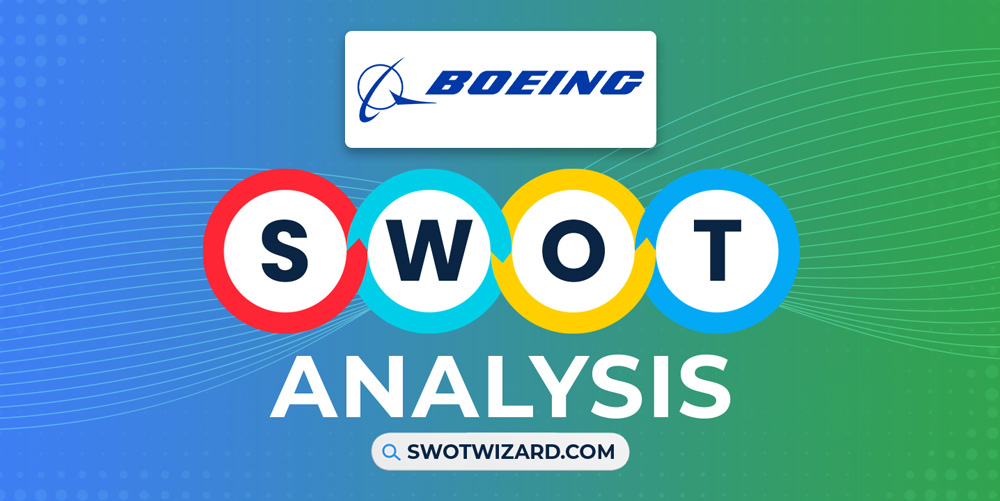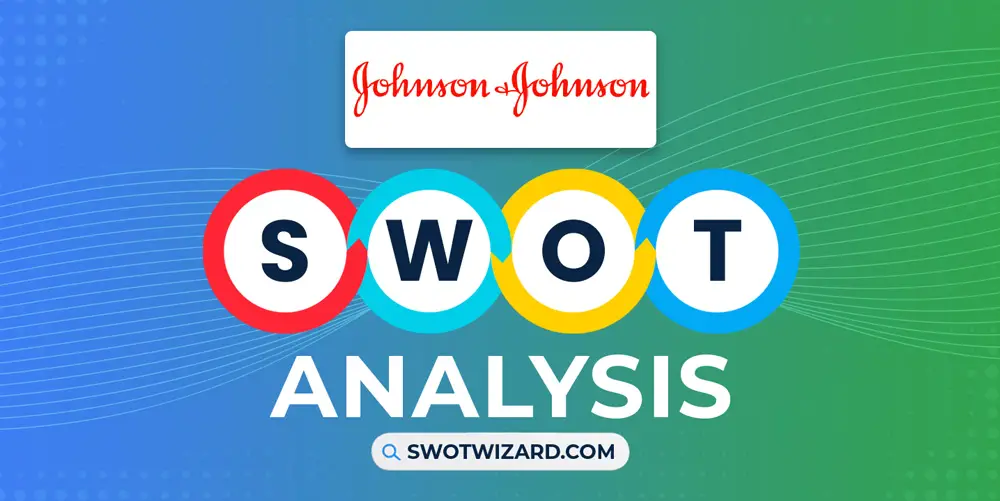Boeing is the first name when I think about planes or flying somewhere for a meeting or vacation, regardless of the company. Thanks to the “Boeing 747”, when we think of an airplane, we imagine the plane whether we even saw the plane or not.
Behind the success is the company’s long history that has made it this far. In this Boeing swot analysis, we will get to know more.
Boeing: Company Overview
| Company | The Boeing Company |
| Industry | Aerospace, Defense |
| Founded | 15 July, 1916 |
| Founder | William E. Boeing |
| CEO | Dave Calhoun |
| Headquarter | Arlington County, Virginia, U.S. |
| No. of Employees | 156,000+ |
| Annual Revenue | $66.61 billion (FY 2022) |
| Website | boeing.com |
The Boeing Company started its country in the middle of WWI in Seattle, Washington, in 1916. The American military, NASA, and the company have a long history of the company’s 107 years of history.
Even after WWII, The Boeing B-52 Stratofortress bomber, which entered service in 1955, is still in active service with the United States Air Force, not to mention its history with the Saturn V rocket that sent astronauts to the Moon.
Now, Boeing is still dominating the industry with total revenue in 2022 was $66.608B and over 156,000 employees worldwide, working in various roles from engineering to manufacturing to sales.
Product & Services of Boeing
Airplanes | Rotorcraft | Rockets | Satellites | Telecommunications Equipment | Missiles
Boeing Competitors
Airbus | Lockheed Martin | Raytheon Technologies | Bombardier Inc | General Dynamics | Northrop Grumman
Did You Know?
Boeing’s aircraft have flown over 100 billion miles, the equivalent of 400 trips from Earth to the Sun.
Strengths – Boeing SWOT Analysis

Huge Market Share: With a significant presence in both the commercial and military markets, Boeing has a considerable market share in the aerospace industry. The company has an overall 43% market share globally in the commercial airplane market. Besides, its F-15 and F-18 fighter jets, used by several countries worldwide, show a dominant position in the military aircraft market.
Strong R&D: The aerospace market demands solid research and innovation; no company has survived without it. That’s why the company spent $2.852B in 2022 on R&D, investing heavily in innovative technologies and processes and focusing on advanced materials, artificial intelligence, and autonomous systems.
Diversified Offerings: Boeing is like a big supermarket for planes where you will find anything, starting with commercial airplanes, military aircraft, rotorcraft, satellites, missiles, to telecommunications equipment. The company has many famous offerings, such as the 737 MAX, AH-64 Apache helicopter, GPS III satellite, and the Harpoon anti-ship missile, which helped its diverse product portfolio remain competitive across different markets.
Efficient Supply Chain: With extensive offerings, Boeing can’t run without an effective and efficient supply chain. The company works closely with suppliers to ensure the timely delivery of high-quality components and materials. Boeing’s 787 Dreamliner program has a global supply chain spanning more than 70 countries, with half of the plane’s material coming from suppliers outside the United States.
Strategic Partnerships: The company has established strategic partnerships and collaborations with several companies in the aerospace industry. Boeing has a JV with Embraer to develop and market new commercial aircraft. Additionally, Boeing has partnered with NASA and other organizations to develop space exploration technologies, such as the Space Launch System rocket.
Solid Cash Flow: The company’s financial strength has enabled it to invest in research and development and expand its product portfolio. And behind the scenario, Boeing reported revenue of $66.608B, a 6.94% increase from the previous year. Boeing also has a strong balance sheet, with cash and cash equivalents of $17.22 B and a total asset value of $109.523B.
Weaknesses – Boeing SWOT Analysis
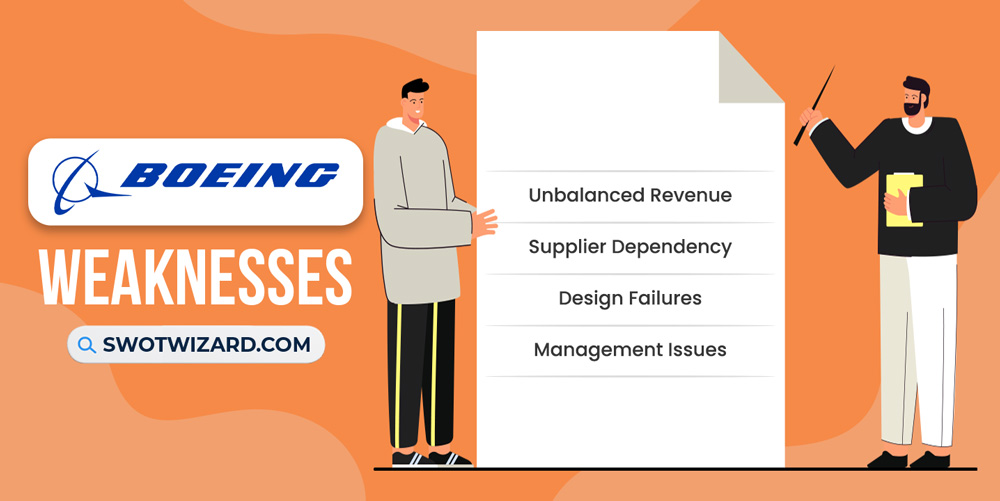
Unbalanced Revenue: Boeing’s revenue has historically relied heavily on its commercial and defense airplane division, which accounts for around 72% of its total revenue in 2022. The company’s commercial airplane division generated $25.8B in revenue, while its defense, space, and security division generated $23.16B.
Supplier Dependency: The company spent $63B on purchases from over 10K suppliers worldwide in 2022 in more than 35 countries. A significant portion of the supplies come from outside the USA, and they heavily relied on them, which led to supply chain disruptions and delays in production, as happened with the 787 Dreamliner’s production delays.
Design Failures: Airplanes are known to be the safest transportation medium on earth, but because of design failures in recent years, including the 737 MAX aircraft, which was involved in two fatal crashes, that statement felt not accurate. As a result, they had to ground the plane and not to mention its significant reputational damage for Boeing.
Management Issues: The company’s management has been criticized for prioritizing profits over safety and not adequately addressing issues with the 737 Max’s design. As a result, Boeing has paid billions of dollars in fines and compensation to victims’ families. Besides, till now, they are not correctly addressing the management issues to resolve them.
Opportunities – Boeing SWOT Analysis

Increase Production Capabilities: Boeing’s increased production capabilities present a significant opportunity for the company to meet the growing demand for its products. In 2021, their delivery was only 340 planes, but with the ongoing demand, Boeing announced plans to increase the production rate of its 737 aircraft to 52 per month by 2025.
Sustainable Offerings: The world and people demand more sustainable offerings, not just to tackle all the negative impacts and overall sustainability programs. As a part of the process, Boeing is investing in sustainable aviation fuels, developing eco-friendly aircraft, and investing in renewable energy. Besides, It has committed to reducing its carbon emissions by 50% by 2050.
Market Expansion: To mitigate the unbalanced revenue portfolio risk and overall single-market dependency, it is high time for the company to expand its operations, particularly in emerging markets. The Asian market is ripe for the take, as it is now the fastest-growing airline market with a 6.37% growth rate and 2.1B of flights.
Strategic Acquiring: Innovation is part of the aviation industry process; it costs a lot in the R&D process and takes brilliant minds to develop ideas. Boeing acquired aerospace parts supplier KLX Inc. for $3.2B to compete in the market to expand its services business a few years back. Besides, it has 33 acquisitions in its portfolio.
Electric Planes: The company is already started working on its ecoDemonstrator program and with other companies, such as NASA and JetBlue, to develop electric and hybrid-electric aircraft. As a result, they recently invested $450M into the autonomous electric plane program.
Threats – Boeing SWOT Analysis
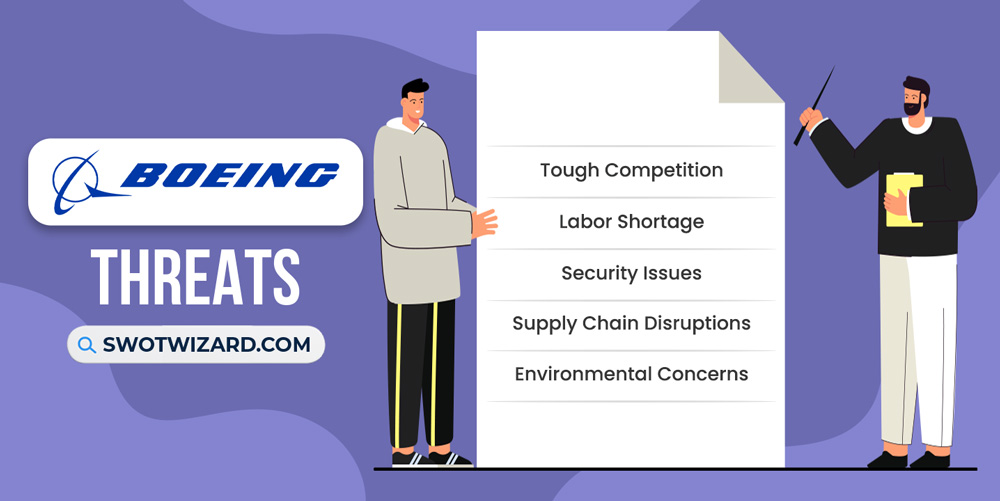
Tough Competition: The company has one primary competitor, Airbus. Airbus has recently surpassed Boeing regarding commercial aircraft deliveries and orders, delivering 661 aircraft compared to Boeing’s 480 in 2022. New players, such as China’s COMAC and Russia’s United Aircraft Corporation, are also entering the market, creating further competition for Boeing.
Labor Shortage: The labor shortage has led to production delays and increased costs for the company. Recently, the company reported a shortage of about 10,000 skilled workers, including mechanics, engineers, and technicians, costing the company millions and decreasing efficiency.
Security Issues: Boeing recently faced several security issues, including grounding its 737 Max planes following two fatal crashes that killed 346 people and paid $2.5B. Besides, the company has faced cybersecurity challenges and allegations of inadequate security measures at some facilities.
Supply Chain Disruptions: As efficient as the company might be, it is still lagging in many sections of the entire SCM, including delays in the production and delivery of its 737 MAX aircraft due to issues with its suppliers. And the problems aren’t going away any sooner, as 2023 will be another year of supply chain disruptions.
Environmental Concerns: The world is compassionate about carbon emissions and overall environmental impacts on all industries, including aerospace, as a significant portion of the carbon emissions comes from this industry. As a result, Boeing announced plans to deliver commercial airplanes capable of using 100% sustainable fuels by 2030.
[Bonus Infographic] SWOT Analysis of Boeing
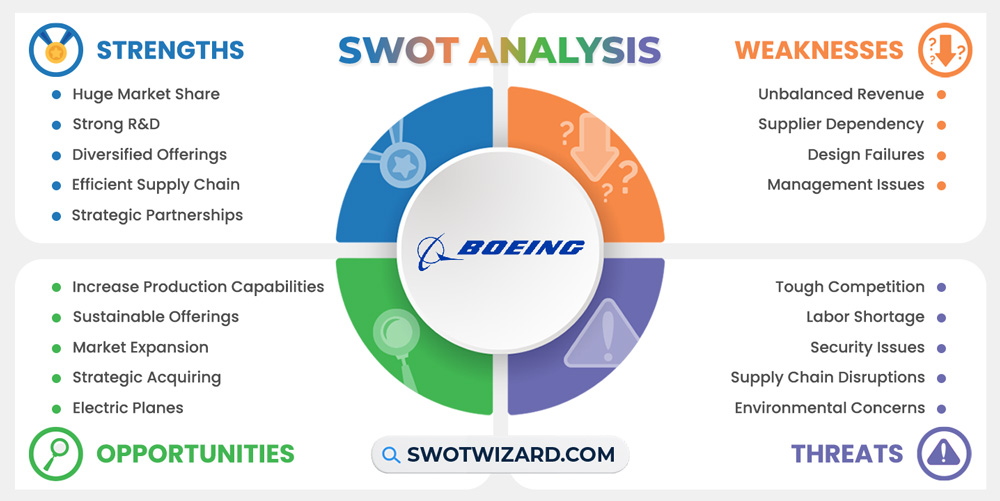
Recommendations for Boeing
The world is not the same as it was ten years ago, let alone 100 years ago when the company was founded. As the world moves forward, things have changed, and it’s time to tackle new weaknesses and threats.
- The company should work to strengthen its supply chain and ensure that it has the resources and capabilities to meet the demand.
- Continuing to invest in research and development to develop new products and technologies will help the company diversify its offerings.
- Boeing must prioritize safety and quality in all aspects of its operations, as there are recent incidents regarding crashes.
- Boeing could emphasize developing sustainable aircraft and reducing its carbon footprint.
- Boeing could consider expanding its product portfolio in new markets or segments, including Asian markets and electric planes.
Frequently Asked Questions (FAQs)
What Is The Full Name Of Boeing?
The full name of Boeing is Boeing Airplane Company.
Which Boeing is the Biggest?
The 747-8 is the biggest Boeing.
Final Words on Boeing SWOT Analysis
Boeing has a long history of technological innovation, investment in research and development, and strategic acquisitions to expand its offerings and capabilities. However, in recent years, Boeing has faced safety, environmental, and supply chain issues. The company should prioritize sustainability, increasing production capabilities, and expanding its product portfolio to remain competitive and achieve long-term success.
References
- Wikipedia contributors. (n.d.). Boeing. Wikipedia.
- Root, A. (2022, February 7). Boeing Stock Has a New Problem About Market Share. BARRON’S.
- Chanthadavong, A. (2019, September 24). Boeing to develop AI systems with Defence’s autonomous research centre. ZDNET.
- Boeing’s New Military Satellite Integrates Anti-Jam Payload for Enhanced Battlefield Communication. (n.d.). MediaRoom.
- Johnston, M. (2023). How Boeing Makes Money. Investopedia.
- Hum, T. (2022, May 5). Boeing: 13 problems management isn’t fully recognizing, according to BofA. Yahoo.
- STIFFLER, L. (2022, January 25). Boeing puts $450M into company building electric, autonomous, passenger-carrying planes. GeekWire.
- Spaeth, A. (2022, January 17). New competition for Airbus and Boeing. dw.com.
- Podsada, J. (2023, February 11). Shortage of skilled airplane workers slows aerospace recovery. HeraldNet.
- Boeing expects supply chain problems to last through most of 2023. (2022, June 22). Reuters.

